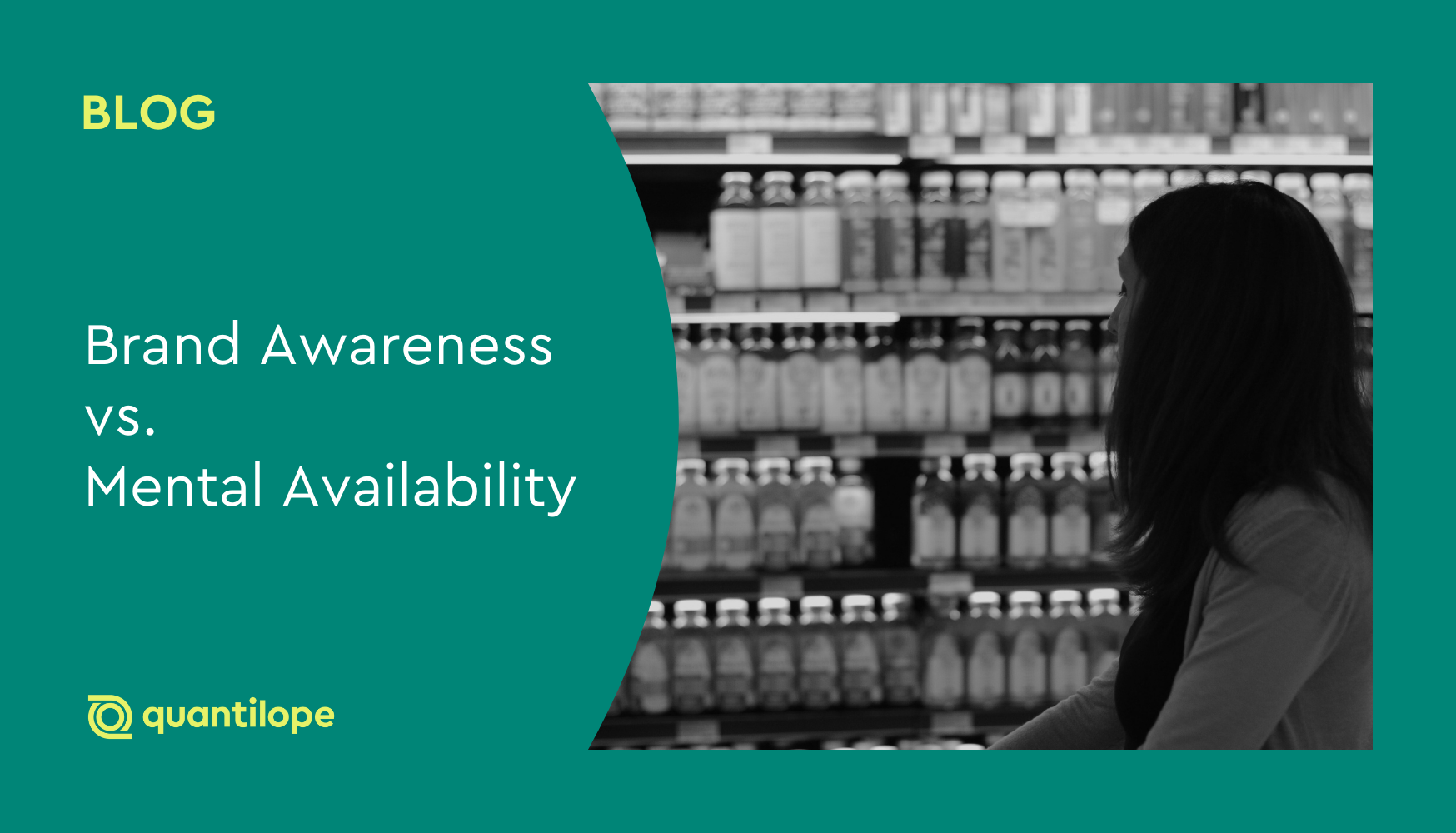In this post, we’ll cover what brand equity is, how to build brand equity up over time, and ways to measure/monitor brand equity over time.
Table of Contents:
- What is brand equity?
- Building brand equity
- How to measure brand equity
- Brand equity management
- The role of customer experience in brand equity
- The economic impact of brand equity
- Automate brand equity research and measurement with quantilope
What is brand equity?
Brand equity is, in simplest terms, the overall value and consumer perception of your brand. It’s an intangible asset, stemming from aspects such as brand name, brand logo, and brand identity (i.e. what consumers think about your brand and how they associate it).Brand equity can grow over time, from increased brand awareness, brand loyalty, perceived quality, and/or new brand associations. Managing brand equity long-term is just as important as measuring it at a point in time, as changes you make based on brand equity metrics can heavily influence how consumers interact with your brand in the future (i.e. gaining new buyers and retaining them as loyal customers).
Brand equity research evaluates the value and perceptions of your brand using both quantitative methods (like online surveys and tracking studies) and qualitative approaches (such as focus groups and interviews). These research initiatives help brands measure awareness, loyalty, quality, and associations more accurately, track their competitive position, and inform strategic decisions that strengthen the brand's financial and emotional value.
Below we’ll touch on some ways to build brand equity, measure its various components, and how to manage it over time.
Building brand equity
Brand equity is never set in stone. It can rise and fall depending on your business decisions and even that state of the market you’re in. Below are a few ways to improve your brand equity - whether you’re building it up for the first time as a new business or bringing it back up after it’s dropped for any number of reasons.
Consistent branding:
Maintaining cohesive, unified branding across all touch points - including messaging, marketing visuals, social media assets, logos/mascots, and customer experience interactions reinforces key brand associations and builds trust among consumers as a reliable, consistent brand. Consumers feel confident in buying from a brand that remains consistent over time - knowing they get what they expect, and consistent branding is a huge part of that. If you think about it - would you buy from a brand that’s constantly changing its look, what it stands for, and how it markets itself?
Many consumers are creatures of habit, and they go to a store looking for the particular packaging of a brand they recognize - maybe a bright yellow canister or a green spray bottle with blue writing. If a brand is constantly switching those aspects (and other branding elements) up, they’ll lose their loyal and steady customers to another brand - and that’s not what brands want. When customers trust a brand and feel loyal toward it, they’re much more likely to recommend it to others through word-of-mouth; this in turn builds positive brand equity.
Product quality and innovation
Brands that deliver high-quality, innovative products are seen as brands that care about evolving consumer needs. Consumers grow and change preferences all the time; brands that grow along with them will be the ones that stand out and distinguish their products from those of competitors.
Similar to the above note on consistent branding, when consumers perceive your brand as one that offers innovative products at a quality they can trust, they’re much more likely to recommend your brand to others (which as you might guess - builds brand equity).
Effective marketing and communication
Building marketing campaigns that resonate with your target audience and effectively communicate your brand's values is likely to build brand equity over time. The same way offering innovative, high-quality products with consistent branding can differentiate yourself from competitors, so does the content of your brand’s messaging; if you have a great product but aren't consistently reminding consumers about it through effective messaging, you're more likely to notice a negative consequence on your brand equity.
Communicating your unique selling points, value proposition, and brand associations through marketing is likely to contribute to stronger emotional bonds with consumers. You want customers to immediately recognize and relate to your marketing efforts, which could be the difference between them choosing your brand or choosing someone else’s.
Back to table of contents
How to measure brand equity
There are many ways to measure brand equity - both quantitative and qualitative.
Quantitative ways to measure brand equity:
-
Online surveys: Brands can use an online market research survey to capture metrics related to brand equity, such as brand awareness, brand recognition (aided and unaided), brand associations, customer satisfaction, and even willingness to pay, as consumers are likely to pay a premium for more valuable products and services. Consumers will provide their quantitative feedback on these metrics that brands can analyze to get a pulse on their brand equity (and competitors’ brand equity - if the survey included competitive brands).
-
Market share and financial valuation: Analyzing publicly available financial metrics such as brand valuation, brand equity ratios, profit margins, and market share help brands quantify their value, understand their market performance, and assess its competitive position in the market (all of which contribute to brand equity in some way).
-
Customer retention and churn: The higher your customer retention rate, the more likely it is that customers are satisfied with your offerings. If they’re not churning and going elsewhere, your brand offers them some value that they either prefer over others, or can’t get anywhere else; these are customers that are likely to recommend your brand to others.
-
Social media and online engagement metrics: Monitoring social media engagement, sentiment analysis, online reviews, and brand mentions can help gauge consumer sentiment and brand perceptions in the digital space. This is key, as online reviews can heavily influence other customers’ willingness to buy. If someone writes a horrible review about your brand on social media, and you do nothing about it, people will notice. The same goes for the alternative; a brand that consistently engages with its target audience on social media is likely to be noticed (for good reason).
-
Employee engagement and satisfaction: While much of brand equity comes from consumer perceptions, employee satisfaction is important to consider as well. The last thing you want is unengaged, unhappy employees who speak poorly of your brand to others. Making sure to align your brand values with employees’ wants and needs can significantly impact brand equity; you can do this by capturing their feedback through anonymous employee engagement surveys.
Qualitative ways to measure brand equity:
For those looking to gather qualitative feedback around their brand equity, there’s qualitative methods such as focus groups or online video feedback tools.
Qualitative tools, like quantilope's inColor solution, allow brands to ask for verbal customer feedback on brand equity related metrics such as brand awareness (e.g. “name a few brands in this category”), brand loyalty (e.g. “which brand do you purchase most often in this category and why”), and brand associations (e.g. “what comes to mind when you hear this brand name?”).
Asking questions qualitatively allows for more expansion and depth; respondents can explain why they have certain associations or feelings toward a brand, the reasons they purchase or don’t purchase from a brand, and so on. Qualitative brand equity findings can be a valuable addition to quantitative brand equity measures, or, can be used as a standalone resource.
Back to table of contents
Brand equity management
Don’t make the mistake of ignoring brand equity once you start to see signs of improvement or positive momentum; managing brand equity requires ongoing effort. Continuously monitor metrics like brand reputation, consumer perceptions, brand loyalty, and more, using tools like quantitative tracking surveys or qualitative feedback solutions. Take prompt action on these brand equity metrics, whether that means investing in new brand partnerships, revamping advertising assets to better align with consumer perceptions, or workshopping a new logo that will attract new customers to your brand. Whenever you make a significant change, be sure to re-measure metrics through a new wave of a tracker or a follow-up qualitative feedback session for long-term brand management.
Customer perceptions and opinions can shift at any moment so you need to stay vigilant in your brand equity monitoring to be able to act quickly.
Back to table of contents
The role of customer experience in brand equity
When people think of brand equity they often immediately think of the brand itself. But a major contributor to a brand’s equity is customer experience. Customer experiences shape how they view a brand; if they have a negative interaction with a customer service representative or they feel the brand isn’t staying relevant with new products that meet modern-day needs, it’ll show through negative brand equity and lower customer loyalty. On the flip side, when customers have positive experiences with a brand, they’re likely to have positive brand associations, high perceived value, and make repeat purchases.
The bottom line is brands that put customers at the center of all they do are much more likely to foster strong relationships and maintain a strong brand experience.
Back to table of contents
The economic impact of brand equity
While a company’s brand has direct impact on how consumers perceive, value, and interact with them, there’s also a huge economic impact attached to brand equity. When consumers consider the value of a brand to be very high (aka, strong brand equity), that brand can justify things like premium pricing and exclusive perks. This results in higher market share, better profit margins, higher competitive rankings, and could even influence a company’s stock price or investor interest.
High brand equity gives brands the potential to charge more, sell more, and earn more - which should be enough to convince any business to take their brand equity seriously and pay close attention to how metrics are changing over time.
Back to table of contents
Automate brand equity research and measurement with quantilope
Implementing a brand equity model or approach doesn’t require a big budget or time investment. It can be as simple as adding brand equity metrics to an online survey or hosting a focus group among your target audience to learn about consumer opinions.
quantilope makes either of the above approaches simple, with drag & drop quantitative surveys or an intuitive qualitative video solution. Through automated survey setup and analysis tools, including the use of quantilope’s AI co-pilot, quinn, businesses can measure and monitor brand equity without any manual effort for data-driven insights that drive sustainable and competitive growth. Run your brand equity study the first time as a base line, and implement new waves in evenly spaced intervals (i.e. every quarter or bi-annually) to see how your metrics are trending.
Setting up a new wave in quantilope’s platform requires no more than a few clicks. Any new data will automatically update existing charts and show trending through automated significance testing. These automated brand equity metrics will support strategic business decisions such as marketing strategy, new product line development, or general brand strategy across any channel.
To learn more about building, measuring, and monitoring brand equity with quantilope, get in touch below!




